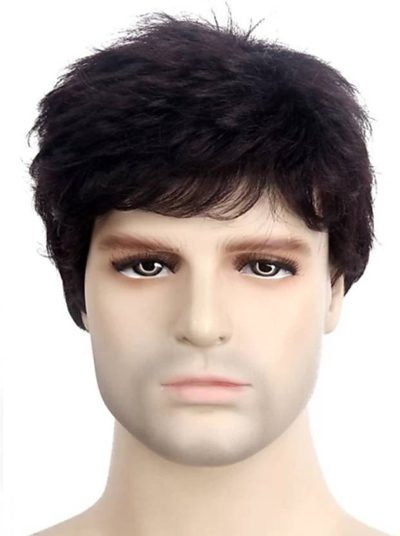Chemotherapy & Alopecia Specialized Wigs For Men
Men who are faced with hair loss from chemotherapy/Alopecia or radiation treatment often choose at least one wig and then alternate wearing the wig(s) with hats and scarves. Remember, your hair will grow back, although its thickness, texture, and color may not be the same as it was before treatment.
What should you do to prepare for hair loss?
- Make sure you actually will need a wig. Not all chemotherapy and Alopecia causes hair loss.
- If your hair is long, consider having it cut short so that switching to a wig or other head covering will be less noticeable.
- Hair generally falls out 2-3 weeks after your first chemo treatment.
- Once it starts falling out, consider having your head shaved (use an electric razor to avoid cuts).
- This can make you feel more in control and keeps you from waking up to find itchy hair all over your pillow.
- If you still need something to catch the hair, you may want to buy a Mesh Cap.
- You may notice that some hair may begin to grow back between treatments, but then fall out again.

Hair usually grows back about eight months after chemotherapy ends. Your new hair may be straighter, Wavy or Curlier, thicker or finer—or even a new color. Usually this change is short term; with time your hair will very likely go back to the way it was before treatment.
Choosing a wig
Before starting treatment
- Take photos of your current hair style. Save a lock of hair from the top front of your head, where the hair is lightest, in case you want to match your wig to your present Hair Structure and Hair color.
- Use natural light—outdoors or near a window—to decide whether a wig matches the swatch.
- Make sure your wig is adjustable; your head size may be up to a size smaller when you lose your hair.
Natural vs synthetic
Wigs can be made either of natural human hair, or of synthetic materials. When comparing a high quality synthetic wig, there is not a lot of difference in the look and feel of the hair. The main differences are in cost and maintenance, so choose the type that’s right for your needs.
Synthetic wigs are cheaper, hold their style regardless of the weather, and don’t fade over time. But they don’t last as long as wigs made of natural hair, and don’t have as much flexibility in styling.
Natural human hair wigs are more expensive and might come in fewer color options, but they can be cut, styled, and dyed just like your own hair. The drawback is that they’ll also need more maintenance, will react to weather, and might need restyling or re-dying over time.
Also consider how long you expect to keep the wig, and whether you would rather have a single wig that lasts a long time, or whether you’d like to change up your look more often with two or more wigs.
Choosing a color
The choice of color is a personal one, but there are a few general rules:
- As we age, a lighter color is often more flattering and gives a softer, more natural look.
- Chemo can make your face look pale. If you have black hair, consider choosing Natural Black or Natural brown for a more flattering look.
- If you’re a brunette and going grey, consider choosing a wig in a lighter shade of brown, possibly with subtle highlights.
- White is very flattering, too.
Fitting your wig
When choosing a wig, look for one that’s adjustable; your head size may be up to a size smaller when you lose your hair.
- Carefully follow the directions that come with the wig.
- Remove the hair net it comes in, and shake out the wig.
- If you wear glasses, remove them before trying on the wig.
- Holding the wig at the sides, with the woven label in the back, place it at the middle of your forehead and slide it on from front to back. Then adjust the top front of the wig’s cap so that it’s about 1″ past your natural hairline. The wig won’t look natural if it’s pulled too far down in front and it should never be placed over your ears.
- The ear tabs should be even and slightly in front of your ears. Push the wire in the tabs towards your face to make the wig lie flat against your head.
- If the wig slides up, you need a larger size.
- If it’s too big, roll it up once it’s on your head to adjust the back tabs.
Consider getting a cushioned wig grip band to hold the wig securely and comfortably, or a wig liner to make the wig more comfortable to wear. Chemotherapy/Alopecia can make your scalp sensitive, and a wig liner can offer protection, as well as keeping you cooler and more comfortable.
Styling your wig
- Before styling, always tuck all of the hair behind your ears.
- Bring forward only as much hair as is needed to make the wig look natural.
- If needed, have a hairdresser trim the bangs and thin the wig to make it look more natural.
- On shorter wigs, use a brush as little as possible. Instead, use your fingers and a special wig styling cream, if you like, to create and hold a style.
- To touch up a style, lift the hair with a hair pick, but slip the pick out, instead of pulling all the way through to the end, so that the wig doesn’t become too full.
- Before styling long straight wigs, always spray lightly with a wig conditioner and use a wig brush, starting with the ends first.
- For a more natural look, don’t try to have every hair in place.
- Use scarf bands and other hair accessories as you would with your own hair.
Caring for your wig
- To avoid damaging your wig, use only special wig care products.
- Wigs that are worn daily should be washed every 12-15 days, and more often if you’re using a lot of hair spray and styling cream.
- Shampoo according to the instructions that come with the wig, towel blot and spray lightly with wig conditioner.
- Allow the wig to dry on a portable wig stand so that air can circulate through it without rinsing out the conditioner. Wig conditioner build-up is good for wigs. It protects the fiber and extends the life of the wig.
- Keep in mind that wigs, especially those that are synthetic, may take up to 8-12 hours to dry.
- Wig Ulster, or a similar product, should be used after the wig has been washed several times, to restore its original sheen.
- Wigs should always be stored on a stand, not in a plastic bag or in a box.
Avoid hair dyes and heat
Synthetic wigs can not be dyed and should only be shampooed with a wig shampoo. To prevent the glue in the wig from melting, shampoo in cool water and avoid using a blow dryer except on the cool setting. Be careful opening the doors of the oven and clothes drier and avoid getting the wig near the burners on the top of the stove.
No more “bad hair days!”
While losing one’s hair may be frightening, many men enjoy trying styles and colors in a wig that they would never have dared to try with their own hair. Some Men buy more than one wig and change wigs to suit their mood, their outfit,Hair Style or the occasion.
Wigs always look good; there are no more bad hair days. In fact, many Men continue to wear their wig(s) after their hair grows back, especially when they don’t have time to get their hair done.
Give yourself permission to try new colors and Hair styles. You may well bring a smile to your face and to the faces of those who love you. (And you may get some compliments, too!)





Comments
Post a Comment